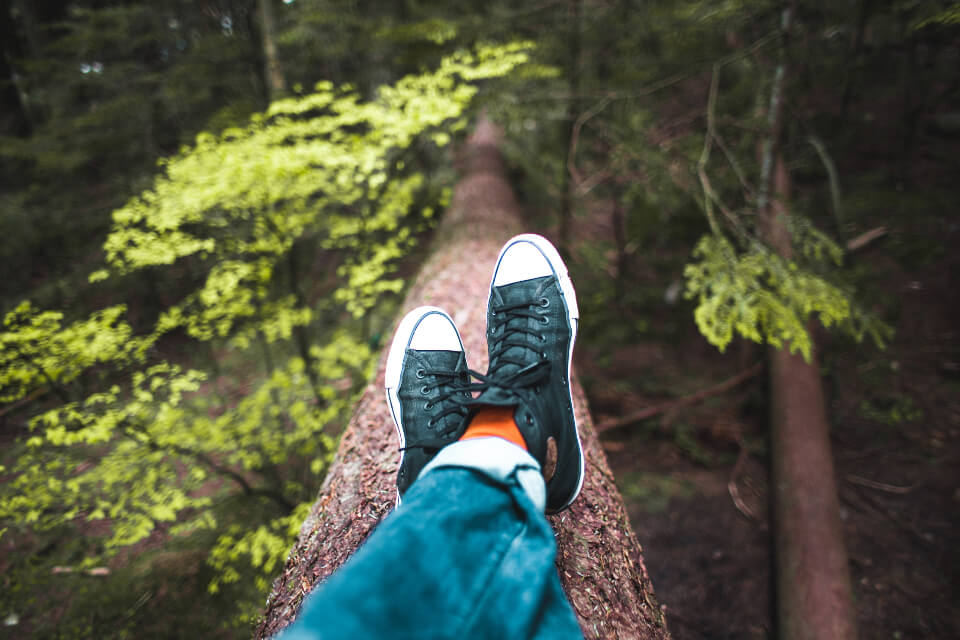New York Summer Hiking and Jogging Tips

Your friend or companion won’t hike with you in the biting cold, so you take the winters off. And when spring finally comes, you can’t wait to hit those trails- whether they be our mountains upstate or the flat, but scenic trails on the Bronx River Parkway… You head out at every opportunity.
And now our hot summer temperatures have arrived ☀
(Photo: Saxon Woods Hiking Trail)
Prepare for all the sweating.
Moisture will seep from your skin, and your clothes will feel damp and cling to your skin. You’ll wish for clouds to capture the intense radiant heat blazing down from that luminous yellow disk in the afternoon sky.
The sweat will drip past your eyebrows and burn your eyes.
Dried sweat will leave patches of salty dust on your cheeks. Bugs will buzz and some might (will probably) bite. You’ll be easily parched and begging a higher being for any kind of drink.
The sun is too intense and even under the shade, the hot air is practically suffocating, and suddenly you don’t want to be out!
Don’t let this hobby restrict you this summer.
The summer heat can also bring delight! Breezes feels welcoming and cooling. Splashing cold creek water on your face has never felt more invigorating. Taking a dip or swim never felt more refreshing. Follow these tips to help you feel more comfortable in the hot, hot summer heat.
Hiking and Jogging Tips for this Heat
- Keep your clothing and skin wet to stay cool. When your clothes are sweaty (or wet), your loss of heat is increased 5 times. Use this to your benefit in the heat! Whenever you are near water, make sure that you wet yourself down. Staying WET is one of the best things that you can do to help decrease your core body temperature and make a difference in how comfortable you feel.
- Avoid hiking between 10AM and 4PM. Start your hike predawn and finish late. Take a long break near shade and water during the hottest part of the day. Even if you are eating and drinking correctly, you still need to avoid hiking in direct sunlight during the hottest part of the day. Sun temperatures are 15F to 20F (9C-11C) degrees hotter than shade temperatures.
- Always carry a headlamp/lightweight flashlight so you can hike out after dark in the event of illness, injury, or enjoyment
Consider Your Clothing
If you know how to make yourself more comfortable wearing the right clothing and proper hydration, you will feel soooo much better in the heat.
- Wear a Sun Hat. Hats not only prevent sunburn but are also useful for keeping insects off your head.
- Look for a hat with a 360-degree brim to protect your face, ears, and neck. Make sure the material is flexible so it can easily cinch into your backpack. Mesh fabric on the top helps with ventilation.
- Consider baseball caps and visors if you’re concerned about aesthetics- at least to keep the sun out of your face!
- Wear clothing with an ultraviolet protection factor (UPF) rating. UV clothing is a great choice if you will be hiking in open, exposed areas or do not want to use sunscreen. UPF in the fabric will not fade or wash off over time.
- Wear a loose or semi-fitted sweat-wicking shirt and tight, moisture-wicking socks. Keep your clothing loose enough to allow for adequate air circulation. A waffle pattern allows for greater breathability and dries very quickly.
- Wicking material for socks is essential for keeping feet dry and preventing blisters. Merino Wool blends (best) or Coolmax Polyester blends (good). While polyester is great for wicking moisture, it is not anti-bacterial. Wool is naturally anti-bacterial, which helps control odor.
- Look for wool blends containing at least 60% Merino Wool (not from Australia) and Nylon (for durability) and Spandex (for stretch).
- Make sure your socks fit tightly to prevent blisters on your toes, soles, and ankles.
- Carry rain gear. Light showers may feel good, but a torrential downpour will often bring high winds and temperatures will drop rapidly, which will get you cold quickly. Always carry an ordinary emergency rain suit or jacket.
- If you purchase a poncho, make sure what you are getting is sized to cover you and your backpack. The advantage of a poncho is that it offers good rain protection in a downpour and can be used for other (non-rain) purposes such as as tarp/temporary rain shelter/ground cloth. The main disadvantage is that it is not breathable and you will start to feel damp and uncomfortable after wearing it a while.
If you genuinely enjoy spending time outside, don’t ever expect to stay comfortable. That doesn’t mean outdoor activity makes for a miserable hobby. You can make yourself more comfortable with the proper preparation: improving gear quality & following these summer hiking/jogging tips.

